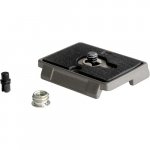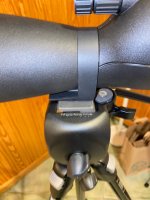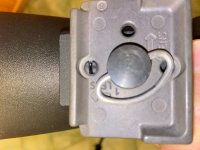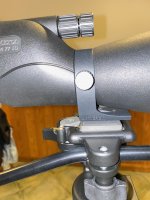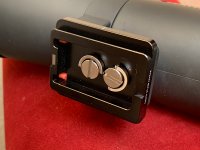I recently purchased a Manfrotto 128 RC QR Micro fluid head and the Opticron 77 mm scope. They are on a Manfrotto tripod. I attached the scope with to the 200PL quick release plate and used the locking screw. The plate underneath says lens 1 and lens 2. I had it attached with the lens 2 arrow pointing towards the lens. The scope has loosed up twice on the plate so I now switched it the orientation of the plate so the lens 1 arrow is facing towards the lens of the scope and moved the locking pin. Do you think this will fix the problem of the scope loosening? Or could there be some other problem? Would appreciate any advice.
-
Welcome to BirdForum, the internet's largest birding community with thousands of members from all over the world. The forums are dedicated to wild birds, birding, binoculars and equipment and all that goes with it.
Please register for an account to take part in the discussions in the forum, post your pictures in the gallery and more.
You are using an out of date browser. It may not display this or other websites correctly.
You should upgrade or use an alternative browser.
You should upgrade or use an alternative browser.
Manfrotto 200PL quick release plate with locking screw (1 Viewer)
- Thread starter ghirl
- Start date
More options
Who Replied?Yes, there is rubber on top. I will try removing it. What about the orientation of the pin and the plate. Should I have the lens1 or lens2 on the plate pointing towards the lens? Does it matter? Oriented towards lens 1 the plate sticks out on the either side oriented toward lens 2 on the plate the plate fits nicely under the scope mount.Does your plate have a rubber covering on top? The old ones have cork. With the rubber covering I find the plates work better with the rubber removed. Metal on metal seems to work a lot better than rubber on metal.
Hermann
Last edited:
Sterngucker
Well-known member
Buying an Arca compliant QR clamp and plates from a reputable manufacturer or, even better, the UniQ/C system which, unlike Arca, actually has normed dimensions will ensure your camera/lens will always stay where you want it. Manfrotto have always done their own thing and that has never been particularly good.
Alexis Powell
Natural history enthusiast

I agree with Hermann--removing the rubber should make the plate much more secure. I'm not huge fan of the 200PL, but they can be quite good when used with the anti-rotation pin. As for the orientation, if it doesn't matter with your head, I'd position it so it fits nicely under the scope foot to get maximum contact and support area. With many Manfrotto heads, the plate orientation is dictated by the head because the head cannot be rotated 90 degrees and still have handle, pivots, and controls pointed in the correct directions (e.g. 700RC2 head requires the plate to be mounted with long axis front-to-back).Yes, there is rubber on top. I will try removing it. What about the orientation of the pin and the plate. Should I have the lens1 or lens2 on the plate pointing towards the lens? Does it matter? Oriented towards lens 1 the plate sticks out on the either side oriented toward lens 2 on the plate the plate fits nicely under the scope mount.
--AP
You are correct with the 128RC head I can only orient the plate with the arrow pointing towards lens 1 or with the plate horizontal to the scope mount. I tried removing the rubber as Hermann suggested and it actually made it worse because when the plate it horizontal to the scope connector the metal of the plate has limited direct contact to the scope mount. Oh well! For some reason I thought I had it attached vertically before I removed it and took the pin out. I guess I will just have to tighten up the screw mount at the end of the day. It seems to loosen when I carry the tripod with the scope mounted on top for even a short distance!I agree with Hermann--removing the rubber should make the plate much more secure. I'm not huge fan of the 200PL, but they can be quite good when used with the anti-rotation pin. As for the orientation, if it doesn't matter with your head, I'd position it so it fits nicely under the scope foot to get maximum contact and support area. With many Manfrotto heads, the plate orientation is dictated by the head because the head cannot be rotated 90 degrees and still have handle, pivots, and controls pointed in the correct directions (e.g. 700RC2 head requires the plate to be mounted with long axis front-to-back).
--AP
Alexis Powell
Natural history enthusiast

Even a small amount of contact should be sufficient if the pin is working properly. Is the metal surface flat, or is there a ridge of metal around the footprint of the rubber piece? I have a Gitzo or Manfrotto plate or two that required running across fine sandpaper or some filing to achieve a flat surface.You are correct with the 128RC head I can only orient the plate with the arrow pointing towards lens 1 or with the plate horizontal to the scope mount. I tried removing the rubber as Hermann suggested and it actually made it worse because when the plate it horizontal to the scope connector the metal of the plate has limited direct contact to the scope mount. Oh well! For some reason I thought I had it attached vertically before I removed it and took the pin out. I guess I will just have to tighten up the screw mount at the end of the day. It seems to loosen when I carry the tripod with the scope mounted on top for even a short distance!
--AP

Are you using the mounting screw AND the anti-rotation pin?
Yes, I have I am using both. The mounting screw is in the middle and the anti rotation pin is at the top. It only loosens up when I am carrying the tripod with the scope attached.Are you using the mounting screw AND the anti-rotation pin?
No the metal surface is not flat. I think that is the problem. The rubber takes up the slack to make it flatter.Even a small amount of contact should be sufficient if the pin is working properly. Is the metal surface flat, or is there a ridge of metal around the footprint of the rubber piece? I have a Gitzo or Manfrotto plate or two that required running across fine sandpaper or some filing to achieve a flat surface.
--AP
Attachments
Last edited:
I had this problem too. The screw does tend to unwind and the scope can become detached when you're not looking. As I only use the tripod with my scope (Zeiss 65mm: so not the heaviest out there) I put a drop of superglue on the anti-rotation pin so the plate is now a permanent part of the scope. That won't suit everyone ,I know, but it certainly does the trick. Very secure.
I guess there’s no way around that Manfrotto proprietary plate with one, center mounting screw.
You need to rely on the pin to prevent the scope from loosening completely.
Instead of relying on a pin I use 2 mounting screws under my arca swiss plate for a solid connection.
You need to rely on the pin to prevent the scope from loosening completely.
Instead of relying on a pin I use 2 mounting screws under my arca swiss plate for a solid connection.
Attachments
I’ve added aftermarket compatible plates to binocukars and scopes so I don’t need to fiddle the plates across. Some allow the pin to engage, others don’t. I’d add a wee bit more rubber and then tighten it down, it should grip both sides well and not undo. I sympathise with the glue, but I’d check it hasn’t quietly failed....
peter
peter
Hans Weigum
Well-known member
as there are some participants mastering German:
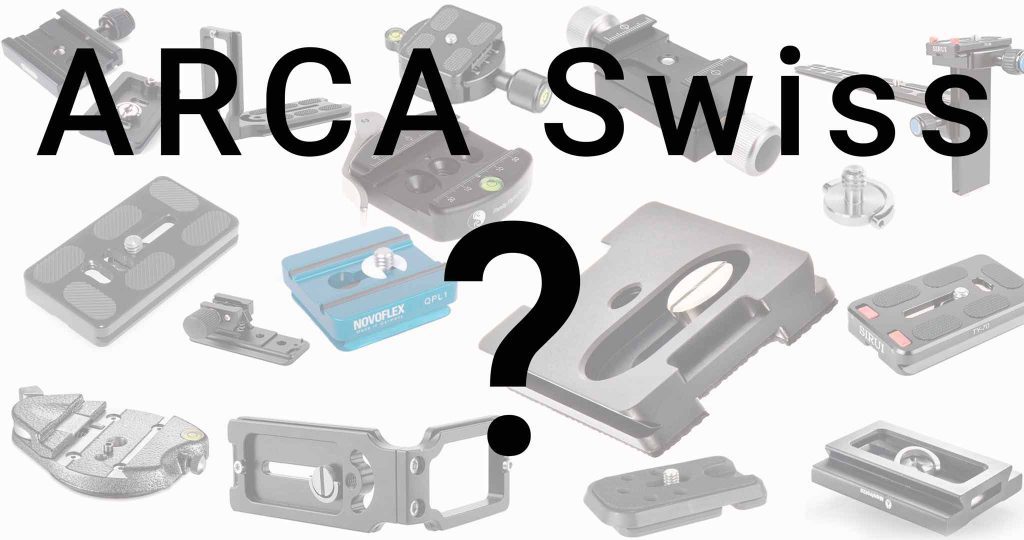
 www.lriese.ch
www.lriese.ch
quoted from there
..........
Ihre Abhandlung über die Kompatibilität innerhalb der Nicht-Original-Arca-Swiss-System-Anbieter ist sehr nützlich. Ich stimme Ihren Beurteilungen weitestgehend zu.
Auch wenn sich Ihre Untersuchung vorwiegend auf die Kompatibilitätsfrage konzentriert, trotzdem folgende Frage: Ist Ihnen eigentlich bewusst, dass dieses System offenbar dominierend werden konnte, obwohl aus der Sicht eines nüchternen Maschinenbauers das zugrunde liegende Konzept eher banal und dessen Realisierung kaum optimiert anmutet?
Dies war doch nur möglich, weil auch die Aufgabenstellungen in der Stativtechnik allgemein kaum besonders anspruchsvoll sind, nicht vergleichbar mit dem Anspruchs-Niveau etwa der eigentlichen Kameratechnik. Schnellwechselsysteme können noch bald einmal, wenn vielleicht auch nicht optimal, doch irgendwie funktionieren.
Die meisten Anbieter versuchen Ihren Banalkonstruktionen einen Anstrich von high-tech zu verleihen, in dem sie, nicht etwa nur Funktionseingriffsflächen, überflüssigerweise aufwendig spanabhebend aus dem Vollen, mit perfektionierten Oberflächen fertigen, was offenbar den Durchschnittskäufer fasziniert.
Denn dieselben echten Funktionen, lassen sich erheblich kostengünstiger, aber visuell weniger attraktiv, mittels fertigungsgerechten Konstruktionen etwa aus Druckguss oder Halbzeug realisieren. Dass nicht einmal Arca-Swiss selbst die Anforderungen an ihre Produkte richtig begriffen hat, zeigt etwa die Platte gemäss Ihrer Abbildung (ARCA Swiss Camera Platte 802208). Dort bedeckt der strukturierte Elastomerbelag die gesamte Platten-Kontaktfläche zum Kameraboden bis unmittelbar zum Loch des Gewindebolzens. In der hier weitgehend gültigen physikalischen Formel für Reibungskräfte: Querkraft= Reibungskoeffizient x Anpresskraft kommt die Grösse der Auflagefläche ja nicht vor. Mit einer Freistellung (=Verringerung) der Auflagefläche nahe um den Gewindebolzen lässt sich eine grössere Anpresskraft auf einem grösseren Radius wirksam werden und somit ein grösseres Verdrehwiderstands-Moment erzielen.
......
unquote
HW

ARCA Swiss Marketing Schwindel?
Was ist der ARCA Swiss Marketing Schwindel? Viele kennen es und viele benutzen es, manche ohne es zu wissen, aber was bedeutet Arca Swiss Standard wirklich?
 www.lriese.ch
www.lriese.ch
quoted from there
..........
Ihre Abhandlung über die Kompatibilität innerhalb der Nicht-Original-Arca-Swiss-System-Anbieter ist sehr nützlich. Ich stimme Ihren Beurteilungen weitestgehend zu.
Auch wenn sich Ihre Untersuchung vorwiegend auf die Kompatibilitätsfrage konzentriert, trotzdem folgende Frage: Ist Ihnen eigentlich bewusst, dass dieses System offenbar dominierend werden konnte, obwohl aus der Sicht eines nüchternen Maschinenbauers das zugrunde liegende Konzept eher banal und dessen Realisierung kaum optimiert anmutet?
Dies war doch nur möglich, weil auch die Aufgabenstellungen in der Stativtechnik allgemein kaum besonders anspruchsvoll sind, nicht vergleichbar mit dem Anspruchs-Niveau etwa der eigentlichen Kameratechnik. Schnellwechselsysteme können noch bald einmal, wenn vielleicht auch nicht optimal, doch irgendwie funktionieren.
Die meisten Anbieter versuchen Ihren Banalkonstruktionen einen Anstrich von high-tech zu verleihen, in dem sie, nicht etwa nur Funktionseingriffsflächen, überflüssigerweise aufwendig spanabhebend aus dem Vollen, mit perfektionierten Oberflächen fertigen, was offenbar den Durchschnittskäufer fasziniert.
Denn dieselben echten Funktionen, lassen sich erheblich kostengünstiger, aber visuell weniger attraktiv, mittels fertigungsgerechten Konstruktionen etwa aus Druckguss oder Halbzeug realisieren. Dass nicht einmal Arca-Swiss selbst die Anforderungen an ihre Produkte richtig begriffen hat, zeigt etwa die Platte gemäss Ihrer Abbildung (ARCA Swiss Camera Platte 802208). Dort bedeckt der strukturierte Elastomerbelag die gesamte Platten-Kontaktfläche zum Kameraboden bis unmittelbar zum Loch des Gewindebolzens. In der hier weitgehend gültigen physikalischen Formel für Reibungskräfte: Querkraft= Reibungskoeffizient x Anpresskraft kommt die Grösse der Auflagefläche ja nicht vor. Mit einer Freistellung (=Verringerung) der Auflagefläche nahe um den Gewindebolzen lässt sich eine grössere Anpresskraft auf einem grösseren Radius wirksam werden und somit ein grösseres Verdrehwiderstands-Moment erzielen.
......
unquote
HW
Users who are viewing this thread
Total: 2 (members: 0, guests: 2)





